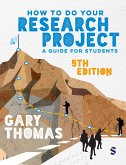Are you struggling with the complexities of literature reviews? This comprehensive guide demystifies the process, offering a flexible toolkit for analysing and synthesizing all types of data. From setting out different options for conducting a literature review to deciding how much literature to include, this book helps you choose the best approach for your research.
Key features of this book include:
. Case studies and worked examples to show you how best to put your knowledge into practice.
. Key learning points and worked exercises to support you with self-learning and project work with others.
. Troubleshooting tips to answer all your questions and help you break down complex processes into adaptable steps.
This book is an ideal toolkit for social sciences students.
Key features of this book include:
. Case studies and worked examples to show you how best to put your knowledge into practice.
. Key learning points and worked exercises to support you with self-learning and project work with others.
. Troubleshooting tips to answer all your questions and help you break down complex processes into adaptable steps.
This book is an ideal toolkit for social sciences students.
Dieser Download kann aus rechtlichen Gründen nur mit Rechnungsadresse in A, D ausgeliefert werden.
The Systematic Approaches to a Successful Literature Review (third edition) by Andrew Booth, Anthea Sutton, Mark Clowes and Marrissa Martyn-St James is a comprehensive overview of the entire evidence synthesis process from selecting the appropriate method for an evidence synthesis topic all the way to the analysis and dissemination of the review. This book is of relevance to anyone interested in evidence synthesis from trainees to researchers to decision-makers. Anyone can learn something from this book, whether you are a beginner, intermediate, or advance researcher in evidence synthesis. This book is perfect for university-level courses or for anyone interested in evidence synthesis. The exercises, toolbox, key learning points, and frequently asked questions were particularly helpful in advancing my learning. Andrea Tricco 20210719









